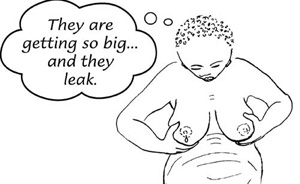Changes in the breasts
In early pregnancy, the breasts may feel full or tingle, and they increase in size as pregnancy progresses. The areola around the nipples (the circle of pigmented skin) darkens and the diameter increases. The Montgomery's glands (the tiny bumps in the areola) enlarge and tend to protrude (stick out more). The surface blood vessels of the breast may become visible due to increased circulation, and this may give a bluish tint to the breasts.

By the 16th week (during the second trimester), the breasts begin to produce colostrum. This is the precursor of breastmilk. It is a yellowish secretion from the nipples, which thickens as pregnancy progresses. It is extremely high in protein and contains antibodies (special proteins produced by the mother's immune system) that help to protect the newborn baby from infection. Near the end of pregnancy, the nipples may produce enough colostrum to make wet patches on the woman's clothes. Reassure her that this is normal and a good sign. After the baby is born, colostrum is produced for about the first three days, before the proper milk begins to flow. Make sure that the mother breastfeeds the colostrum to her baby, so he or she gets all the nutrients and antibodies it contains.